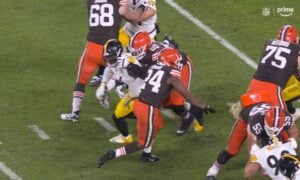The Cleveland Browns are an exceedingly improbable comeback away from being undefeated at 3-0 in this early portion of the regular season. They held a 13-point lead over the New York Jets a week ago with under two minutes to play before giving up the ghost, first on a 66-yard touchdown pass and then after giving up an onside kick recovery that led to a shorter touchdown drive from midfield.
So what happened in those final two minutes that allowed the Jets to so effectively exploit the Browns’ defense? Well, there are inevitably multiple factors under such conditions, but according to Josina Anderson, Cleveland believes one thing that helped New York was is adaptation of using max protection including double chips to keep their edge rushers at bay.
She also writes that the Browns believe the Pittsburgh Steelers attempted to emulate that strategy on Thursday night with Myles Garrett—or rather, that they “tried to ineffectively copy that strategy”, as she wrote on Twitter. It was noted that they saw about 20 chips by the close of that game rather than the typical small handful.
Although this is far from common for teams playing on short weeks, she also writes that she was told the Browns believe they benefited from cutting down the playbook this past game, or rather cutting down on the checks and focusing on single-call plays, defensively.
So what do we make of this as Steelers fans and writers? Well, hearing that a team tried to chip Myles Garrett a bunch doesn’t exactly make me take a seat in astonishment. Opposing teams tend to do that against the great pass rushers, including Pittsburgh’s own T.J. Watt. He even gets triple-teamed on occasion, and that doesn’t always prevent him from getting home.
Personally, I don’t think that this supposed poor emulation of the Jets’ late-game strategy had much of anything to do with the end result of the game. It’s not as though pass protection was a major issue—certainly not the element that you would point to and say ‘this is why they lost’.
But yes, it is true that they did provide more help in pass protection, particularly in the earlier stages of the game. Arguably, that limited what they were willing to do, for example, with tight end Pat Freiermuth during that time, and obviously that limited the number of route runners they would have on any giving passing play.
It can be argued that they oversold on pass protection at the expense of providing Mitch Trubisky with targets to throw to. The Browns’ pass rush was not so potent that it was a major concern throughout the game—but then we have a chicken and egg scenario. Was that because of the pass protection strategy, or the lack of quality pass rush?








